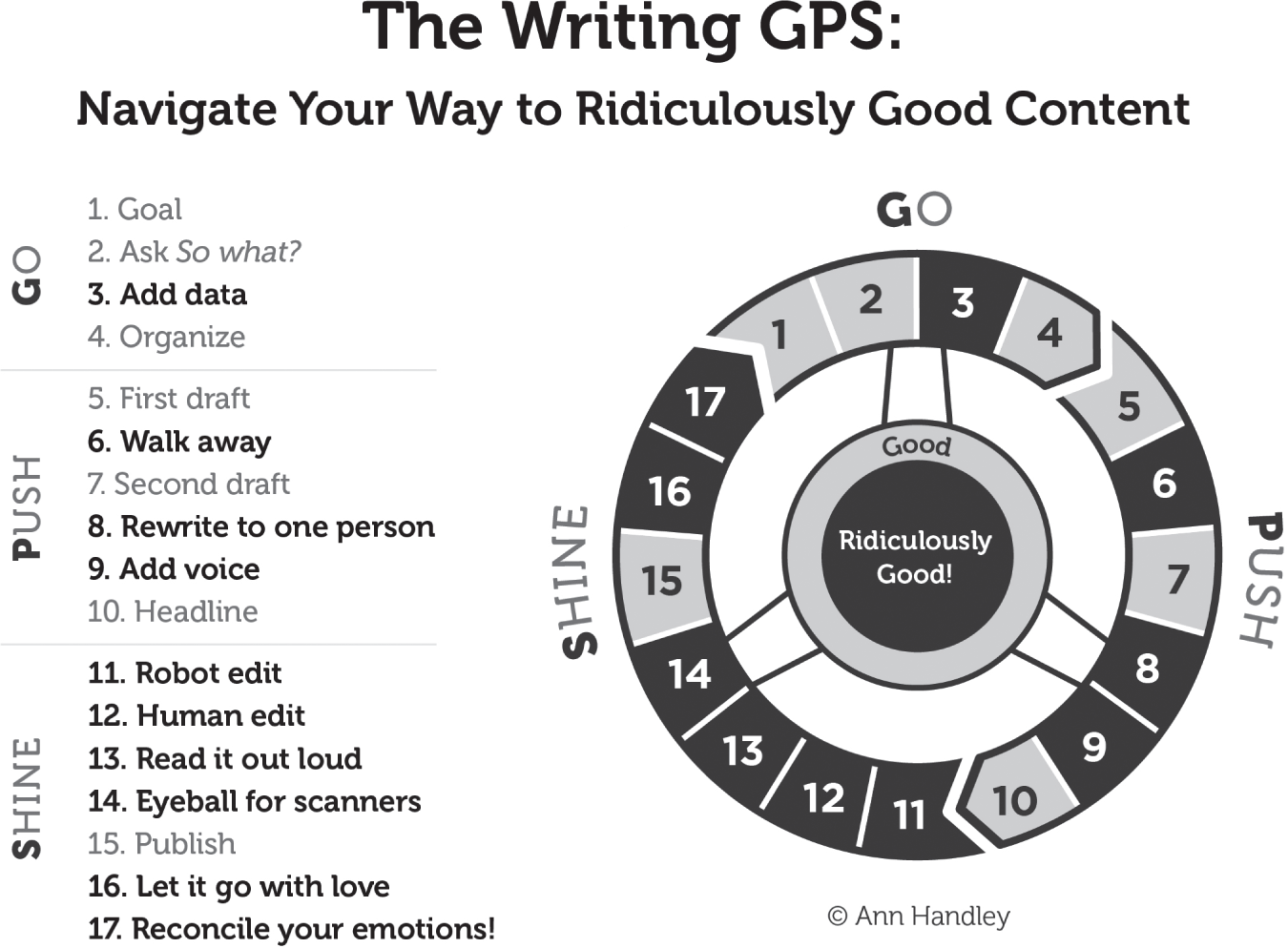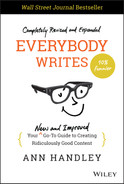7
Introducing the Writing GPS Framework
Introducing the Writing GPS: a framework for any longer pieces you might write—blog posts, ebooks, white papers, newsletters, site content, and so on.
It's the process I use to write anything that's important: articles or posts that appear on MarketingProfs or my own site at AnnHandley.com, my fortnightly newsletter, and this book you're reading.
I've also used it to write the bones of video scripts and presentations, longer memo-style emails, and texts to my kids. (LOL. Just kidding about that last one.)
The Writing GPS has 17 steps.
Let's pause here for a minute. I feel like I know you well enough by Chapter 7 to know that number just made your stomach drop. Did she say 17 steps? SEVEN. TEEN?!
Seventeen is … a lot.
Seventeen sounds … overwhelming.
Seventeen feels … when's naptime?
I promise you: Following this Writing GPS is not exhausting.
Here's the deal: Most of these steps are fleshed out elsewhere in this book. Like serving the reader and not the writer. Finding credible sources or data to support your point of view. Creating The Ugly First Draft (TUFD).
What's more, some are small things you'll do almost automatically or reflexively—more mindset moments than tasks to check off on some project management software.
For example, is Step 6 of “Walk away” actually a “step”? Not really. It's a brain break.
Is “Recognizing the Joy and Regret” of writing actual “work”? No. It's honoring that there's a lot of emotion in creating.
Both so-called steps are part of the journey to ridiculously good writing.
I included all the steps and moments here because it's helpful to see how all these pieces work together to create a larger whole.
We need a framework that goes beyond the basics so that you can see where a little extra effort or attention can make the magic happen. That's what this Writing GPS does.
Here's the framework.

The Writing GPS acts as your guide. It subs in Go Push Shine for the usual words (Global Positioning System) to make the GPS acronym our own.
Our Writing GPS has three distinct parts:
- Go (1–4): The prep and research groundwork
- Push (5–10): The writing and the rewriting
- Shine (11–17): The polishing and the publishing
The framework is a steering wheel because the Writing GPS puts you in the driver's seat. You navigate your own way.
The steps most of us do already are in gray. The specific steps toward ridiculously great content are marked in black.
The seven steps in gray (1, 2, 4, 5, 7, 10, 15) are the required minimum for writing content:
- 1. Goal
- 2. Ask So what?
- 4. Organize
- 5. First draft
- 7. Second draft
- 10. Headline
- 15. Publish
This is the path most of us already take. You travel from the starting point to your You Have Arrived destination with only the most necessary steps in between. These are your gas, food, and bathroom breaks—metaphorically speaking.
The other 10 steps (3, 6, 8, 9, 11, 12, 13, 14, 16, 17) add magic and adventure to a basic journey.
- 3 . Add data
- 6. Walk away
- 8 . Rewrite to one person
- 9. Add voice
- 11. Robot edit
- 12. Human edit
- 13. Read it out loud
- 14. Eyeball for scanners
- 16. Let it go with love
- 17. Reconcile your emotions!
These 10 things—some big (voice!), some small (internalizing the emotion of writing!)—will elevate your writing. You'll create a ridiculously memorable journey for your readers.
Ready? Let's buckle up….
- Goal. What's your goal? What are you trying to achieve? Anything you write—even a standalone blog post—should always be aligned with a larger (marketing or business) goal.
The key here is that you care about what you're writing: You can try to fake it, but readers are allergic to insincerity. If you don't care about what you're writing about, no one will.
Let's say your goal is this: I want to drive awareness of and interest in the launch of our incredibly cool new collaborative editing software because we want to sell more of it.
- So what? Put the reader in it. Reframe the goal to relate it to your reader.
Why does it matter to them? What's in it for them? Why should they care? What's the clear lesson or message you want them to take away?
What value do you offer them? What questions might they have? What advice or help can you provide? How can you best serve them, with a mindset of generosity and giving?
To get to the heart of this reframing, I ask: So what? And then answer, Because.
Repeat the So what/Because query/response string until you've exhausted any ability to come up with an answer. Or until you're questioning things best left to philosophers.
As in:
I want to drive interest and awareness in the launch of our new collaborative editing software.
So what?
Because our new text editor makes it stupid-easy in three specific ways for those without a geek gene to easily collaborate from remote offices, without overwriting each other's stuff or losing earlier versions.
So what?
Because that's a pain to deal with, and it causes a lot of frustration and suffering for collaborative teams working virtually.
So what?
Because pain … it hurts. And suffering is … umm … bad.
You get the idea.
Express your reframed idea as a clear message. In this case, something like this:
Our new text editor makes it stupid-easy in three specific ways for those of you without a geek gene to easily work together from remote locales, without overwriting each other's stuff or losing earlier versions. That makes for happier, less frustrated collaborators. And you'll get your work done faster, with less wasted effort.
Put that sentence or two at the very top of the page. Like a pin on a Google map, it'll remind you where you're headed. (See Chapter 13.)
- Seek out the data and examples. What credible source supports your main idea?
Are there examples, data, real-world stories, relevant anecdotes, timely developments, or new stories you can cite? (See specific advice about using data in Publishing Rules, Part V.)
Don't discount your own experience; at the same time, don't rely exclusively on it. Use yourself as one of your sources if you have relevant experience.
“The more personal you are, the more universal you become,” says writing coach Chip Scanlan. “The writer who uses herself as a source and resource has the greatest chance of connecting with the largest audience.
“[A]sk yourself: What do I think about this story? What do I know about it?” he writes. “The smart writers I know start out by tapping into their own private stock first.”1
So look inward: What's been your own experience?
Then: Is there research that quantifies the problem? Who else has dealt with catastrophes or successes? Could you talk to those people or organizations to get their firsthand stories and advice?
- Organize. What structure best suits your story? A list? A how-to guide? A case study or client narrative? (See Chapter 14.)
- Write The Ugly First Draft. Writing The Ugly First Draft is where you show up and throw up.
Write badly.
Grammar?
Spelling?
Complete sentences?
Readability?
Who cares?
You'll tackle all that later. For now, just get that TUFD down. (See Chapter 8.)
By the way, this show-up-and-throw-up phase is often where some writers start and end the process. But we don't do that, do we? (Heck-no-we-do-not!) We have respect both for writing and for our reader.
- Walk away. Actually go for a walk. Move your body. Free your mind. Put some distance between your first draft and the second. (More also in Chapter 8.)
- Write Draft 2 with fresh eyeballs. Start to shape that mess into something. (See Chapter 9.)
- Write Draft 3 with company. That company is your reader. Draft 3 is when you invite you reader into the room with you.
One reader. Not readers. Not an entire audience.
You've been the writer, writing from your point of view. Draft 3 is where you swap places with your reader, and rewrite from their perspective. (See Chapter 10.)
- Write Draft 4. This is my favorite checkpoint in the GPS!
The checkpoint guards are like your best grandma, so friendly and welcoming! And everything you do is wonderful!
Add voice, style, fun, sparkle, humor, fizz & ginger. (See Chapter 11.)
- Give it a great headline or title. See Chapter 79 for more on writing irresistible headlines.
- Run your final draft through an AI editing tool. I like Grammarly. Hemingway Editor is fun, too, if only for the Ernest name-check.
Adopt or reject AI's suggestions. It's so satisfying to be confident enough in your writing to reject a robot's fixes.
- Send the post-AI edited version to your longtime editor. All writers need an editor. Especially the best ones.
This is the person who has a tight grip on grammar, usage, style, and punctuation. But most importantly, they know you and your style. (More in Chapter 29.)
- Read it out loud. Reading your final draft out loud is the best way to hear your voice, literally. Yeah, you sound like a nutloaf, talking to yourself in the middle of your office. So?
Mistakes I catch during my own Nutloaf MomentTM:
Countless spelling/grammar errors. Awkward phrasing. Hard-to-understand sentences. Moments when I sound too prescriptive or serious or straight. When I sound like I'm reporting a five-car pileup on the freeway on your local news … not writing to one person directly in my own voice.
- Eyeball for scanning/scrolling. Chunky chunks of text feel impenetrable, especially online.
They don't move the reader along, because bulky text doesn't look like much fun to read. (For more, see Chapter 26.)
- Publish—but not without answering one more reader question: What now? Don't leave your readers just standing awkwardly in the middle of the dance floor after the music stops.
What do you want them to do next?
- Check out other resources?
- Subscribe to hear more?
- Register for an event or a free trial?
- Buy something?
- Leave feedback?
- Write you back?
- Let it go with love. Your writing is no longer yours. It's out there in the world, standing on its own two pixels.
- Recognize both Joy + Regret.
Those two things happen post-publishing for me, simultaneously. (Yes still—after a lifetime of writing.)
Regret. It's not exactly what you wanted to write. It's not exactly what you envisioned when you planned this in your head.
Forgive yourself. It's the best you can do right now. Take note of any lessons. Vow to apply them. See you next time.
Joy. HIGH-FIVE YOURSELF. You're gorgeous. You're killing it. You're doing GREAT.
Writing—like life—is complicated.
* * *
Those steps are my process. They don't happen consecutively. Usually they occur over several days.
You can take them and toss them around and follow them however you like.
Maybe you like to barf your first draft onto the page (step 5) and then see what organization makes sense (step 4). Maybe you create fewer drafts.
That's fine. There is no one way to write, remember?
So:
Try this on.
See what works for you.
Trash what doesn't.
Adopt what might.
Adapt as you wish.
Note
- 1. Chip Scanlan, “Ten Paradoxes of the Writing Life, Poynter,” https://www.poynter.org/archive/2002/ten-paradoxes-of-the-writing-life/
